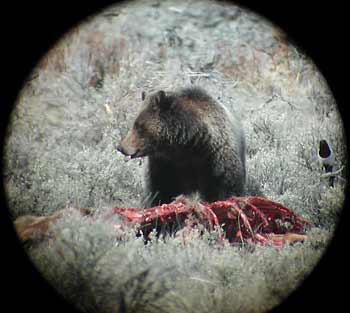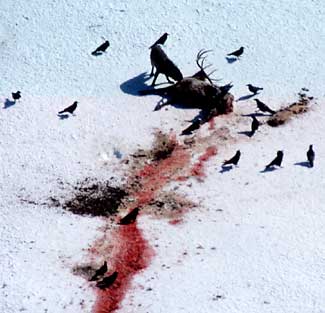 |
A grizzly bear and a magpie pick off the remains of an elk killed by wolves at Yellowstone National Park. (Photo courtesy of Christopher Wilmers) |
Scavengers benefit by dining with the wolves, find new UC Berkeley-led studies
BERKELEY – Two studies led by researchers at the University of California, Berkeley, may help revamp the reputation of the grey wolf, one of the largest, most efficient predators in North America and the subject of controversy when it was reintroduced to Yellowstone National Park in 1995.
The studies of grey wolves in the park's northern range - an area covering 1,530 square kilometers in northwestern Wyoming and southern Montana - reveal that the canines regularly leave their meals unfinished, a dining habit that benefits other animals in the ecosystem. This behavior is a departure from that of other top predators, which abandon their kill only under duress.
Christopher Wilmers, a UC Berkeley researcher in ecosystem sciences, uses radio telemetry to track wolf packs at Yellowstone National Park. (Photo courtesy of Christopher Wilmers) |
"Like other large carnivores, wolves will gorge on their prey until their bellies are full," said Christopher Wilmers, a doctoral student in ecosystem sciences at UC Berkeley's College of Natural Resources and lead author of both papers, which appear this month in two scientific journals. "What happens is that wolves can only eat about 20 pounds of meat before they need to lie down and let the food digest. Even a relatively large pack of about 15 wolves can't finish off an adult elk, which can weigh 500 to 700 pounds, in one sitting. So while the wolves move away from the carcass to sleep off their meal, scavengers move in to consume the leftovers."
The researchers noted that other large predators, such as grizzly bears and mountain lions, tend to rest on top of or right next to their kill, making the carcass inaccessible to other scavengers.
Wilmers and Wayne Getz, UC Berkeley professor of environmental science, policy and management and Wilmer's Ph.D. advisor, worked with researchers from the Yellowstone Wolf Project and the Yellowstone Ecological Research Center for the studies.
The study appearing in the Journal of Animal Ecology examines why wolves abandon their kills and looks at what happens to the carrion remains, while the study in Ecology Letters focuses on how wolf kills compare with leftovers provided by human hunters.
Before these new studies, little was known about the benefits wolves provide to the ecosystem, the researchers said.
Wolves once spanned North America, but they were targeted for elimination as predators and nearly wiped out by 1970. When the U.S. Fish and Wildlife Service first proposed the reintroduction of wolves into Yellowstone in 1987, there were dire predictions that wolves would severely impact elk, deer and moose populations. There has been no conclusive evidence to date that such an impact has occurred.
The researchers studied the grey wolves between November and July from 1998 to 2001. Following signals from radio-collared wolves, the researchers tracked packs to their kill sites. Using a high-powered scope to observe the feedings from a distance, the researchers calculated the amount of meat consumed based upon the feeding time.
 A coyote picks off the remains of an elk killed by a wolf. Coyotes, one of the main scavengers in Yellowstone's Northern Range, visit virtually every wolf-killed elk in the area. (Photo courtesy of Daniel Stahler, Yellowstone Wolf Project) |
The researchers also found that the more severe the weather conditions, indicated by increases in snow depths, the more scraps the wolves left for others to share.
"The deeper the snow, the harder it is for prey animals like elk, moose and deer, to get to vegetation on the ground," said Wilmers. "They get weaker, making them easier prey for top predators like wolves. So food becomes plentiful for wolves during the winter, particularly harsh ones. And when food is plentiful, wolves tend to leave more meat for others to share."
But just as importantly, the researchers found that wolves share their bounty with other animals steadily throughout the winter. Before the wolves' reintroduction into the ecosystem, there would be a glut of carrion at the end of the winter as elk, deer and other animals weakened with starvation die. But a large proportion of the meat ends up rotting and going to waste because the few scavengers that survived the preceding lean months cannot eat them quickly enough.
"It was the feast followed by the famine," said Getz. "Having a large pulse of food accumulate at the end of the winter is not conducive to maintaining a strong scavenger population. It's much better to spread the availability of carcasses throughout the year so the scavenger population can maintain healthier levels. The wolves are doing their job as top predators by culling out weak individuals gradually throughout the year."
The stabilizing influence wolves bring to the ecosystem is also illustrated when comparing wolf kills with human hunter kills, which were observed during Montana's Gardiner Late Elk Hunt outside the border of Yellowstone in 2001 and 2002. In recent years, the Gardiner Late Hunt, which begins in January, lasts six weeks and averages 1,000 elk kills, accounted for approximately 80 percent of the annual hunter take in Yellowstone's northern range.
The researchers calculated that, in contrast to wolves, the gut piles left over from hunter kills are concentrated in both time and space. Between November and May, wolves provide an average of 29,000 pounds of meat for a diverse range of scavengers. From January to mid-February, human hunters provide 73,000 pounds, on average.
And since local scavengers are not able to finish off all the meat left by hunters in such a short amount of time, the excess meat primarily benefits mobile scavengers such as ravens and bald eagles that come from far away to feast.
 A freshly killed elk is surrounded by ravens and magpies waiting for a wolf to finish its meal. The remains of animals killed by wolves is so important to the scavenger community that they arrive on the scene immediately after a kill is made. (Photo courtesy of Daniel Stahler, Yellowstone Wolf Project) |
Douglas Smith, chief scientist of the Yellowstone Wolf Project and co-author of both papers, said this research illustrates the complexity and delicate balance inherent in natural ecosystems.
"For a long time, people thought that human hunting was a surrogate for large carnivores," said Smith. "This line of research clearly shows that that's not true. Human hunting is not the same as having wolves in the ecosystem. We had no idea how the ecosystem operated with the dominant carnivore intact. We are now finding that it's more important than we ever imagined."
The U.S. Environmental Protection Agency, the Yellowstone Ecological Research Center and a Canon grant to the National Park Service helped support this research.

